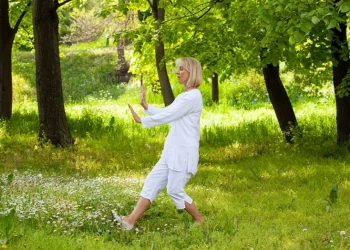In our fast-paced modern world, the simple act of walking has become something we rush through without a second thought. Yet ancient Chinese traditions offer a profound alternative: qigong walking, a practice that transforms every step into a meditation, every breath into healing energy, and every moment into an opportunity for cultivating vitality and inner peace.
Understanding Qigong: The Foundation
Before exploring qigong walking specifically, it’s essential to understand qigong itself. The term “qigong” (pronounced “chee-gong”) combines two Chinese characters: “qi” (氣), meaning life force or vital energy, and “gong” (功), meaning skill or cultivation through practice. Qigong represents thousands of years of Chinese wisdom about cultivating and balancing the body’s vital energy to promote health, longevity, and spiritual development.
Traditional Chinese medicine views the human body as a complex network of energy channels called meridians, through which qi flows. When this energy flows freely and harmoniously, we experience health and vitality. When it becomes blocked or imbalanced, illness and discomfort arise. Qigong practices, including qigong walking, aim to maintain optimal energy flow through specific movements, breathing techniques, and mental focus.
What Is Qigong Walking?
Qigong walking is a moving meditation practice that integrates the principles of qigong with the natural act of walking. Unlike ordinary walking, which we typically perform automatically while our minds wander, qigong walking demands complete presence and awareness. It transforms walking into a deliberate practice that coordinates breath, movement, and intention to circulate qi throughout the body.
This practice can take many forms, from slow, deliberate stepping that resembles tai chi to more natural-paced walking infused with qigong awareness. Some styles emphasize specific patterns or movements, while others focus primarily on breath coordination and mental presence. Despite these variations, all qigong walking practices share common elements: mindful awareness, coordinated breathing, relaxed yet aligned posture, and the intention to cultivate and circulate vital energy.
Core Techniques of Qigong Walking
Posture and Alignment
The foundation of qigong walking begins with proper posture. Practitioners maintain a relaxed but upright stance, as if suspended from above by a thread attached to the crown of the head. The spine remains naturally aligned, shoulders relaxed and slightly back, chest softly open without puffing out. The pelvis tilts slightly forward to release tension in the lower back, and the knees remain soft and unlocked.
The head position is crucial: the chin tucks slightly, lengthening the back of the neck, while the gaze extends forward and slightly downward, taking in the surroundings without fixating. This alignment creates an unobstructed pathway for energy to flow from earth through the body to heaven, and back again.
The Walking Pattern
In qigong walking, each step becomes intentional and deliberate. The weight transfers gradually and smoothly from one foot to the other, maintaining balance and rootedness. As you prepare to step, the weight shifts entirely onto the supporting leg while the other foot becomes light and empty. The empty foot then lifts with the heel first, moves forward, and places down with the heel touching first, followed by a gentle roll through to the whole foot.
The pace varies depending on the style and practitioner’s needs. Some practices employ extremely slow movement, where a single step might take 30 seconds or more, requiring tremendous concentration and leg strength. Others use a more moderate, natural walking pace, making the practice more accessible and suitable for longer distances.
Breath Coordination
Breathing forms the vital bridge between body and mind in qigong walking. The most common pattern coordinates breath with steps: inhaling for several steps (often 2-4), then exhaling for an equal or slightly longer number of steps. The breath should be deep, natural, and originate from the lower abdomen (the dantian, located about two inches below the navel), rather than shallow chest breathing.
As you inhale, imagine drawing fresh qi up from the earth through the feet, filling the body with vital energy. As you exhale, release stale energy downward and outward, letting go of tension and negative emotions. Some practitioners also visualize breathing in through the feet and exhaling through the hands, creating a complete energy circuit.
Mental Focus and Intention
The mind plays an equally important role as the body in qigong walking. Practitioners maintain a state of “sung” (松), often translated as “relaxed alertness” or “alert tranquility.” This mental state combines complete relaxation with focused awareness—neither forcing nor spacing out.
Focus might center on different aspects: feeling the connection between feet and earth, sensing energy moving through the body, maintaining breath awareness, or simply observing thoughts without attachment while returning attention to the present moment. Some practitioners recite mantras or visualize specific energy pathways to deepen their practice.
Qigong Walking vs. Tai Chi Walking: Understanding the Differences
While qigong walking and tai chi walking share many similarities and are both rooted in Chinese philosophical and energetic principles, they have distinct characteristics that are worth understanding.
Origins and Context: Tai chi is a specific martial art form that has evolved into a popular health practice. Tai chi walking is typically an element within broader tai chi practice or a supplementary exercise. Qigong walking, on the other hand, encompasses a wider variety of walking practices from different qigong traditions, each with its own emphasis and methodology.
Structure and Form: Tai chi walking tends to follow more prescribed patterns derived from tai chi forms. Movements often incorporate specific martial applications, such as shifting weight in particular ways or coordinating arm movements that mirror tai chi postures. Qigong walking can be more free-form, ranging from very structured specific stepping patterns to simply walking with qigong awareness and principles.
Emphasis and Goals: Tai chi walking often emphasizes rootedness, balance, and the martial concept of substantial and insubstantial (yin and yang in the legs). The practice develops the fundamental tai chi skill of weight shifting and stability. Qigong walking places primary emphasis on energy cultivation and circulation, though balance and rootedness remain important. The intention is often more explicitly therapeutic and meditative.
Pace and Style: Tai chi walking is typically slow and deliberate, matching the characteristic tempo of tai chi forms. Qigong walking can vary widely in pace, from extremely slow meditative walks to more natural speeds, depending on the style and purpose.
That said, the boundaries between these practices blur considerably. Many tai chi practitioners incorporate qigong principles into their walking, while qigong walkers often adopt tai chi’s emphasis on body mechanics. Both practices ultimately aim to cultivate health, balance, and harmony through mindful movement.
The Multifaceted Benefits of Qigong Walking
Physical Health Benefits
Qigong walking offers numerous physical benefits, many of which have been documented in scientific research. The practice improves balance and coordination, particularly valuable for older adults concerned about falls. The deliberate weight shifting and conscious proprioception (body awareness in space) strengthen the stabilizing muscles and enhance the neural pathways that maintain equilibrium.
Cardiovascular health improves through regular practice, even at slower paces. The coordinated breathing and movement increase circulation without the stress of intense exercise, making it suitable for people with various fitness levels. Studies have shown that qigong practices can help reduce blood pressure, improve heart rate variability, and enhance overall cardiovascular function.
The practice also strengthens the legs, core, and postural muscles. Maintaining proper alignment while walking, especially at slow speeds, requires sustained muscular engagement that builds endurance and tone. The gentle, low-impact nature makes it accessible to people with joint issues who cannot tolerate high-impact exercise.
Mental and Emotional Well-being
The meditative quality of qigong walking provides profound benefits for mental health. The practice naturally reduces stress by activating the parasympathetic nervous system, shifting the body from “fight or flight” mode to “rest and digest.” The combination of rhythmic movement, focused breathing, and present-moment awareness creates a moving meditation that calms the mind and reduces anxiety.
Regular practitioners often report improved mood, emotional regulation, and resilience to stress. The practice develops mindfulness—the ability to maintain awareness of the present moment without judgment—which research has linked to reduced depression and anxiety, improved emotional processing, and enhanced overall psychological well-being.
Concentration and mental clarity also improve through qigong walking. The practice demands sustained attention, training the mind to focus despite distractions. This mental discipline translates to other areas of life, enhancing productivity and the ability to remain present during daily activities.
Energy and Vitality
From the Chinese medicine perspective, qigong walking’s primary purpose is cultivating and balancing qi. Practitioners often report feeling more energized yet simultaneously relaxed after practice. This paradoxical effect reflects the practice’s ability to both generate energy and release blockages that cause tension and fatigue.
The practice is believed to open and clear the meridians, allowing qi to flow more freely throughout the body. This improved energy circulation supports all bodily functions, from digestion and immune response to healing and cellular regeneration. While Western science might attribute these effects to improved circulation, stress reduction, and enhanced mind-body connection, many practitioners experience the energetic dimension directly as warmth, tingling, or a sense of flow in the body.
Spiritual Development
For those seeking deeper practice, qigong walking offers a path for spiritual cultivation. The practice can become a moving prayer or meditation, a way to connect with something greater than oneself. The rhythmic, meditative quality naturally quiets the chattering mind, creating space for insight, intuition, and a sense of connection to nature and the cosmos.
Some traditions view qigong walking as a way to harmonize personal energy with environmental energy, absorbing beneficial qi from natural settings while releasing negative energy back to the earth for transformation. This perspective transforms a simple walk in nature into a profound exchange with the living world.
Getting Started with Qigong Walking
Beginning a qigong walking practice requires no special equipment or location, though certain conditions enhance the experience. Natural settings—parks, forests, beaches—offer abundant fresh qi and fewer distractions than urban environments. However, you can practice anywhere with adequate space for safe walking, even indoors.
Start with short sessions of 10-15 minutes, gradually extending as comfort and stamina increase. Begin each session by standing quietly, settling the mind, and bringing awareness to the breath and body. Set an intention for your practice, whether cultivating specific qualities like peace or energy, or simply being present.
Walk at whatever pace feels comfortable, prioritizing breath awareness and relaxation over perfect technique. Over time, the body naturally learns the proper mechanics through consistent practice. Consider learning from a qualified instructor, either in person or through reputable online resources, to ensure you develop good habits from the start.
Pay attention to how you feel during and after practice. Some people experience immediate benefits, while others need several weeks of consistent practice before noticing changes. Be patient and approach the practice with curiosity rather than rigid expectations.
Qigong walking represents a profound yet accessible practice that transforms the ordinary act of walking into an extraordinary tool for health, healing, and self-cultivation. By integrating breath, movement, and awareness, this ancient practice offers modern people a way to reconnect with their bodies, quiet their minds, and tap into the vital energy that sustains all life.
Whether practiced as moving meditation, gentle exercise, or spiritual cultivation, qigong walking provides a path to greater well-being that requires nothing more than your body, your breath, and your willingness to be present. In a world that constantly pulls our attention outward and demands ever-increasing speed, qigong walking invites us to slow down, turn inward, and discover the healing power of simply being present with each mindful step.



